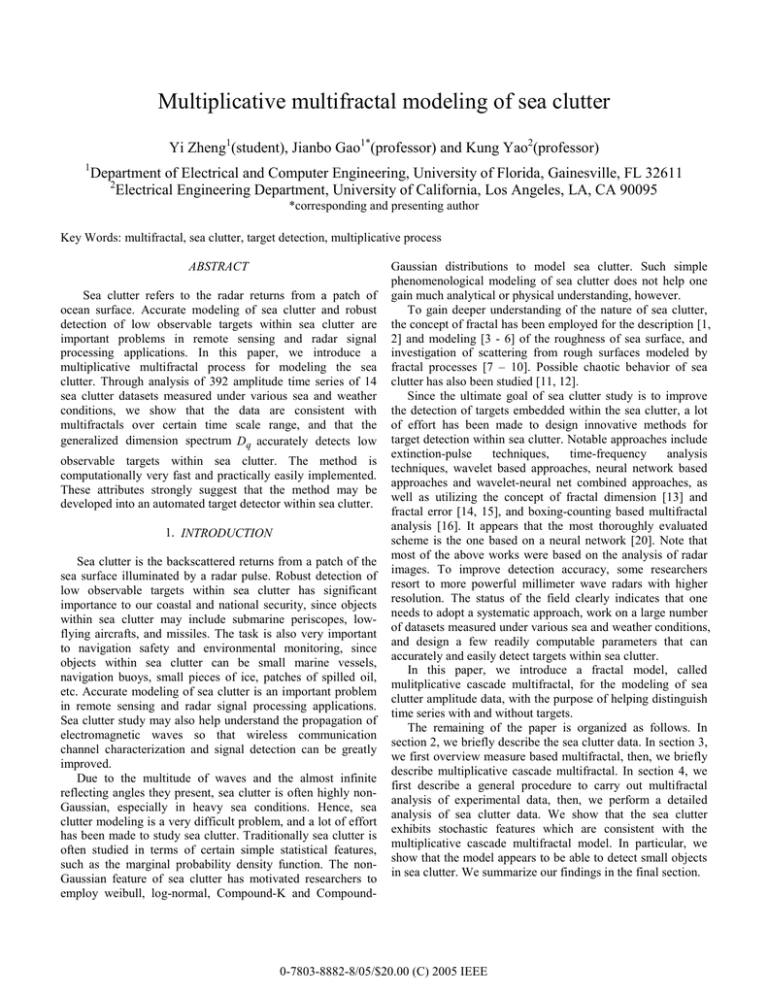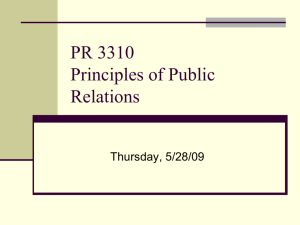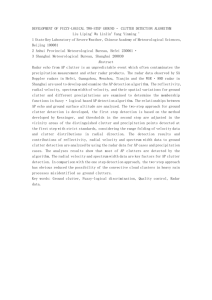Multiplicative multifractal modeling of sea clutter
advertisement

Multiplicative multifractal modeling of sea clutter
Yi Zheng1(student), Jianbo Gao1*(professor) and Kung Yao2(professor)
1
Department of Electrical and Computer Engineering, University of Florida, Gainesville, FL 32611
2
Electrical Engineering Department, University of California, Los Angeles, LA, CA 90095
*corresponding and presenting author
Key Words: multifractal, sea clutter, target detection, multiplicative process
ABSTRACT
Sea clutter refers to the radar returns from a patch of
ocean surface. Accurate modeling of sea clutter and robust
detection of low observable targets within sea clutter are
important problems in remote sensing and radar signal
processing applications. In this paper, we introduce a
multiplicative multifractal process for modeling the sea
clutter. Through analysis of 392 amplitude time series of 14
sea clutter datasets measured under various sea and weather
conditions, we show that the data are consistent with
multifractals over certain time scale range, and that the
generalized dimension spectrum Dq accurately detects low
observable targets within sea clutter. The method is
computationally very fast and practically easily implemented.
These attributes strongly suggest that the method may be
developed into an automated target detector within sea clutter.
1. INTRODUCTION
Sea clutter is the backscattered returns from a patch of the
sea surface illuminated by a radar pulse. Robust detection of
low observable targets within sea clutter has significant
importance to our coastal and national security, since objects
within sea clutter may include submarine periscopes, lowflying aircrafts, and missiles. The task is also very important
to navigation safety and environmental monitoring, since
objects within sea clutter can be small marine vessels,
navigation buoys, small pieces of ice, patches of spilled oil,
etc. Accurate modeling of sea clutter is an important problem
in remote sensing and radar signal processing applications.
Sea clutter study may also help understand the propagation of
electromagnetic waves so that wireless communication
channel characterization and signal detection can be greatly
improved.
Due to the multitude of waves and the almost infinite
reflecting angles they present, sea clutter is often highly nonGaussian, especially in heavy sea conditions. Hence, sea
clutter modeling is a very difficult problem, and a lot of effort
has been made to study sea clutter. Traditionally sea clutter is
often studied in terms of certain simple statistical features,
such as the marginal probability density function. The nonGaussian feature of sea clutter has motivated researchers to
employ weibull, log-normal, Compound-K and Compound-
Gaussian distributions to model sea clutter. Such simple
phenomenological modeling of sea clutter does not help one
gain much analytical or physical understanding, however.
To gain deeper understanding of the nature of sea clutter,
the concept of fractal has been employed for the description [1,
2] and modeling [3 - 6] of the roughness of sea surface, and
investigation of scattering from rough surfaces modeled by
fractal processes [7 – 10]. Possible chaotic behavior of sea
clutter has also been studied [11, 12].
Since the ultimate goal of sea clutter study is to improve
the detection of targets embedded within the sea clutter, a lot
of effort has been made to design innovative methods for
target detection within sea clutter. Notable approaches include
extinction-pulse
techniques,
time-frequency
analysis
techniques, wavelet based approaches, neural network based
approaches and wavelet-neural net combined approaches, as
well as utilizing the concept of fractal dimension [13] and
fractal error [14, 15], and boxing-counting based multifractal
analysis [16]. It appears that the most thoroughly evaluated
scheme is the one based on a neural network [20]. Note that
most of the above works were based on the analysis of radar
images. To improve detection accuracy, some researchers
resort to more powerful millimeter wave radars with higher
resolution. The status of the field clearly indicates that one
needs to adopt a systematic approach, work on a large number
of datasets measured under various sea and weather conditions,
and design a few readily computable parameters that can
accurately and easily detect targets within sea clutter.
In this paper, we introduce a fractal model, called
mulitplicative cascade multifractal, for the modeling of sea
clutter amplitude data, with the purpose of helping distinguish
time series with and without targets.
The remaining of the paper is organized as follows. In
section 2, we briefly describe the sea clutter data. In section 3,
we first overview measure based multifractal, then, we briefly
describe multiplicative cascade multifractal. In section 4, we
first describe a general procedure to carry out multifractal
analysis of experimental data, then, we perform a detailed
analysis of sea clutter data. We show that the sea clutter
exhibits stochastic features which are consistent with the
multiplicative cascade multifractal model. In particular, we
show that the model appears to be able to detect small objects
in sea clutter. We summarize our findings in the final section.
0-7803-8882-8/05/$20.00 (C) 2005 IEEE
2. SEA CLUTTER DATA
We have obtained 14 sea clutter datasets from a website
maintained by Professor Simon Haykin:
http://soma.ece.mcmaster.ca/ipix/dartmouth/datasets.html.
The measurement was made with an IPIX radar of RF 9.39
GHz (and hence a wavelength of about 3 cm). The grazing
angle varied from less than 1 degree to a few degrees. The
wave height in the ocean varied from less than 0.8m to 3.8m
(with peak height up to 5.5m). The wind conditions varied
from still to 60 km/hr (with gusts up to 90 km/hr). We analyze
two polarizations, HH (horizontal transmission, horizontal
reception) and VV (vertical transmission, vertical reception).
Each dataset contains 14 spatial range bins of HH as well as
14 range bins of VV time series. Therefore, there are a total of
392 time series. A few of the range bins hit a target, which
was made of a spherical block of styrofoam of diameter 1 m,
wrapped with wire mesh. The range bins where the targets are
strongest are called primary bins, while neighboring range
bins where the targets may also be visible are called secondary
17
bins. Each range bin data contains 2 complex numbers,
with a sampling frequency of 1000 Hz. We analyze the
amplitude data. Two typical time series are shown in Figs. 1(a,
b).
probabilities {wi } , and associate the weight
wi with the
ith interval. Now consider the moments
M q (ε ) = ∑ wiq ,
(1)
i
where q is real. Note the convention that whenever wi is zero,
the term
wiq is dropped. We also note that a positive q value
emphasizes large weights, while a negative q value
emphasizes small weights. If we have a real function τ (q ) of
q,
M q (ε ) ~ ε τ ( q ) , as ε → 0
for every q, and the weights
(2)
{wi } are non-uniform, then the
weights wi (ε ) are said to form a multifractal measure. Note
∑i wi = 1 implies that τ (1) = 0 .
that the normalization
Note that if
{wi } are uniform, then τ (q ) is linear in q.
When {wi } is weakly non-uniform, visually τ (q ) may still be
approximately linear in q. The non-uniformity in {wi } is
better characterized by the so called generalized dimensions
Dq , defined as [18]
Dq =
τ (q )
q −1
,
(3)
Dq is a monotonically decreasing function of q [17]. It
exhibits a nontrivial dependence on q when the weights
{wi } are non-uniform.
stage
1
0
r11
1
r11r21
2
Fig.1 Sea clutter amplitude data from the same dataset.
(a) range bin without target, (b) range bin with primary target
3. MULTIPLICATIVE CASCADE MULTIFRACTALS
In this section, we first overview the definition of the
measure based multifractals. This type of multifractals is
typically constructed through multiplicative processes.
3.1 Definition
Consider a unit mass with unit interval, and partition the
mass into a series of small intervals, each of linear length ε.
Also partition the unit mass into a series of weights or
3
r11r21r31
1 − r11
r11(1 − r21 ) (1 − r11 ) r23 (1 − r11 )(1 − r23 )
r11r21 (1 − r31 )
•
•
•
●
●
●
Fig.2 Schematic illustrating the construction rule of a
multiplicative multifractal.
3.2 Construction of multiplicative multifractals
To better appreciate the construction rules, we point out
that these rules essentially involve dyadic partitions.
Consider a unit mass with a unit interval. Divide the mass
into two segments of equal length, with associated mass r and
1-r, and assign them to the left and right segments,
0-7803-8882-8/05/$20.00 (C) 2005 IEEE
respectively. The parameter r is in general a random variable,
governed by a probability density function (pdf)
P(r ),0 ≤ r ≤ 1. The fraction r is called the multiplier. Each
new subinterval with associated weight is further divided into
two parts following the same rule. This procedure is
schematically shown in Fig. 2, where the multiplier r is written
as rij , with i indicating the stage number, and j (assuming
M q (ε ) ≈ 2 N E ( w q ) = 2 N E ((u1 " u N ) q ) = 2 N µ qN .
only odd numbers thus leaving even numbers for 1 − rij )
The property indicates that a multiplicative process is a
multifractal, and relates the τ (q ) spectrum to the moments of
the multiplier distribution. One of the simplest examples is
random binomial multiplicative process, for which the
multiplier
distribution
is
given
by
P(r ) = [δ (r − p) + δ (r − (q − p))] / 2 , where δ ( x) is
Kronecker delta function. For this process, we have
indicating the positions of a weight on that stage. Note the
µ q = [ p q + (1 − p) q ] / 2, thus, τ (q) = − ln[ p q + (1 − p ) q ] / ln 2.
−i
scale (i.e., the interval length) associated with stage i is 2 .
We assume that P(r ) is symmetric about r = 1 / 2 , and has
4.
successive moments µ1 , µ 2 , " Hence rij and 1 − rij both have
marginal distribution P(r ) . The weights at the stage N,
{wn , n = 1," ,2 N },
can
be
expressed
as
wn = u1u 2 " u N , where ul , l = 1,", N , are either
rij or 1 − rij , thus, {u i , i ≥ 1} are independent identically
distributed random variables having pdf P(r ) . The function
P(r ) can be selected to follow any functional form [17].
To appreciate the effectiveness of the cascade process in
modeling sea clutter data, Figs.3(a, b) show two simulated
time series, one intended to model the measured data of Fig.1
(a), the other for Fig.1 (b). We observe that the model is quite
good.
MULTIPLICATIVE MULTIFRACTAL
ANALYSIS OF SEA CLUTTER
In this section, we show that the sea clutter data exhibit
stochastic features consistent with the stochastic behavior of
random multiplicative processes over certain time scale range.
We shall further show that these features can be used to detect
targets in sea clutter.
Let us first describe the general procedure for computing
the moments M q (ε ) defined in Eq. (1) at different stages,
and checking whether Eq. (2) is valid for certain ε range.
Assuming we use 2 N consecutive amplitude data. For ease of
illustration, we denote the square of raw data by {xi } . We
view {xi , i = 1,2 " 2 N } as the weight series of a certain
multiplicative process at stage N. Note that the total
weight
N
∑12 xi
is set equal to 1 unit. Also note the scale
associated with stage N is ε = 2 − N . This is the smallest time
scale resolvable by the measured data. Given the weights at
stage j+1, { X i( 2
stage j, { X i( 2
N− j
N − j −1
)
)
, i = 1, ",2 j +1}, we obtain the weights at
, i = 1, ",2 j }, by adding consecutive weights
at stage j+1 over non-overlapping blocks of size 2.
X i( 2
N− j
)
N − j −1
N − j −1
)
= X 2( 2i −1 ) + X 2( 2i
for i = 1, ",2 j . Here the superscript 2 N − j for X i( 2
N− j
)
is used
to indicate that the weights at stage j can be equivalently
obtained by adding consecutive weights at stage N over nonoverlapping blocks of size 2 N − j . The scale associated with
stage j is ε = 2 − j .
Fig.3 Simulated time series using multiplicative process.
(a, b) Simulating sea clutter data in Fig. 1(a, b) respectively.
3.3 Why cascade processes are multifractals
To show that cascade processes are multifractals, let us
prove the following property for the weights at stage N [19].
Theorem:
M q (ε ) ~ ε τ ( q ) with ε = 2 − N ,τ (q) = − ln(2µ q ) / ln 2.
After we have obtained all the weights from stage 1 to N,
we compute the moments M q (ε ) according to Eq. (1) for
different values of q. We then plot log M q (ε ) vs. log ε for
different values of q. If these curves are linear over wide range
of ε, then the weights are consistent with a multifractal
measure. Note that, according to Eq. (2), the slopes of the
linear part of log M q (ε ) vs. log ε curves provide an estimate
of τ (q ) , for different values of q.
This follows the observation that at stage N,
0-7803-8882-8/05/$20.00 (C) 2005 IEEE
Fig.4 log M q (ε ) vs. log ε curves of sea clutter amplitude
data in the same measurement. (a) HH data with primary
target; (b) VV data with primary target; (c) HH data without
target; (d) VV data without target.
We illustrate the above procedure by using all 217 points
of each sea clutter dataset for this analysis, which is around
130 seconds. Figs. 4(a - d) show representative
log M q (ε ) vs. log ε curves for (a) a HH polarization data
with primary target, (b) VV data with primary target, (c) HH
data without target, and (d) VV data without target. We
observe that the degree of linearity between log M q (ε ) and
log ε for all data sets is quite good up to the 15th stage.
To further check whether these data sets are truly
multifractals, we compute Dq for certain ε range. Here we
Fig.5 The generalized dimension spectrum
(a) HH and (b) VV amplitude dataset.
We have systematically studied all 392 time series of 14
sea clutter datasets. To better appreciate the detection
performance, we have first focused on bins with primary
targets, but omitted those with secondary targets, since
sometimes it is hard to determine whether a bin with
secondary target really hits a target or not. After omitting the
range bins with secondary targets, the frequencies for
the D q (q = 30) under the two hypotheses (the bins without
targets and those with primary targets) for VV datasets are
shown in Fig.6. We observe that the accuracy for the detection
is very good, except for one primary bin. Careful examination
of the amplitude time series data of the exceptional VV bin
reveals that the bin is much noisier than other measurements.
Therefore, the generalized dimension spectrum Dq can
accurately detect low observable targets within sea clutter.
focus on the range from stage 6 to stage 12, corresponding to
the time scale range of 32ms to about 2s, which especially
exhibits the difference of the structure features between range
bins with and without targets. Note here we mainly focus on
large weights, which are emphasized by positive q.
Representative results of Dq are shown in Fig.5. Indeed, we
observe that in all cases Dq has a nontrivial dependence on q.
Therefore, we conclude that these time series are consistent
with multifractals. More important, Dq with a big positive
value can distinguish the range bin with target. For example,
when q = 30 , the Dq values given by the range bins with
targets are much closer to 1 than those given by the range bins
without targets.
Fig.6 The PDFs of the bins without targets
and with primary targets for VV datasets
0-7803-8882-8/05/$20.00 (C) 2005 IEEE
5. CONCLUDING REMARKS
In this paper, we introduce a multiplicative multifractal
process, a convenient means for modeling sea clutter
amplitude data. Through analysis of 392 amplitude time series
of 14 sea clutter datasets measured under various sea and
weather conditions, we show that the data are consistent with
such multifractals over certain time scale range. Furthermore,
we have found that the generalized dimension spectrum
Dq can accurately detect low observable targets within sea
clutter. The method thus may be very helpful in developing an
automated target detector within sea clutter.
2.
3.
4.
5.
6.
7.
9.
10.
11.
12.
REFERENCES
1.
8.
A.I. Morrison and M.A. Srokosz, “Estimating the fractal
dimension of the sea-surface - a 1st attempt”, Annales
Geophysicae-Atmospheres HYdrospheres and Space Sci,
11, pp. 648-658 (1993).
M. Martorella, F. Berizzi, E.D. Mese, “On the fractal
dimension of sea surface backscattered signal at low
grazing angle IEEE”, IEEE Trans. Antennas &
Propagation, 52, pp. 1193-1204 (2004).
J. Chen, T.K.Y. Lo, H. Leung, J. Litva, “The use of
fractals for modeling EM waves scattering from rough sea
surface”, IEEE.Trans. Geoscience & Remote Sensing, 34,
pp. 966-972 (1996).
F. Berizzi, E. Dalle-Mese, G. Pinelli, “One-dimensional
fractal model of the sea surface”', IEE Proceedings-Radar
Sonar and Navigation, 146, pp. 55-64 (1999)
F. Berizzi, E. Dalle-Mese, M. Martorella, “A sea surface
fractal model for ocean remote sensing'”, International
Journal of Remote Sensing, 25, pp. 1265-1270 (2004).
A. Collaro, G. Franceschetti, M. Migliaccio, D. Riccio,
“Gaussian rough surfaces and Kirchhoff approximation”,
IEEE Trans. Antennas & Propagation, 47, pp. 392-398
(1999)
G. Franceschetti, A. Iodice, M. Migliaccio, D. Riccio,
“scattering from natural rough surfaces modeled by
13.
14.
15.
16.
17.
18.
19.
20.
fractal brownian motion two-dimensional process”, IEEE
Trans. A & P, 47, PP. 1405-1415 (1999).
S. Savaidis, P. Frangos, D.L. Jaggard, K. Hizanidis,
“Scattering from fractally corrugated surfaces: an exact
approach”, Optics Letters, 20, pp. 2357-2359 (1995).
X. Sun, D. L. Jaggard, “Wave scattering from nonrandom fractal surfaces”, Optics Communications, 78, pp.
20-24 (1990).
F. Berizzi, E. Dalle-Mese, ``Scattering from a 2-D sea
fractal surface: Fractal analysis of the scattered signal”,
IEEE Trans. Antennas & Propagation, 50, pp. 912-925
(2002).
S. Haykin and S. Puthusserypady, “Chaotic dynamics of
sea clutter”, Chaos, 7, pp. 777-802 (1997)
J.B. Gao, S.K. Hwang, H.F. Chen, Z. Kang, K. Yao, and
J.M. Liu, “Can sea clutter and indoor radio propagation be
modeled as strange attractors?” The 7th Experimental
Chaos Conference, San Diego, USA, August, pp. 25-29
(2002).
T. Lo, H. Leung, J. Litva and S. Haykin, “Fractal
characterisation of sea-scattered signals and detection of
sea-surface targets”, IEE Proc F140, pp. 243-250 (1993).
C.-P. Lin, M. Sano, and M. Sekine, “Detection of radar
targets by means of fractal error”, IEICE Trans. Commun.
E80-B, pp. 1741-1748 (1997).
B.E. Cooper, D.L. Chenoweth, and J.E. Selvage, “Fractal
error for detecting man-made features in aerial images”,
Electronics Letters, 30, pp. 554-555 (1994).
D. Gan, Z. Shouhong, “Detection of sea-surface radar
targets based on multifractal analysis”, Electronics
Letters, 36, pp. 1144-1145 (2000).
J.F. Gouyet, “Physics and fractal structures”, Springer,
New York, 1995.
H.G.E. Hentschel and I. Procaccia, “The infinite number
of generalized diensions of fractals and strange
attractors”, Physical D, 8, pp. 435-444, 1983.
J.B. Gao and K. Yao, “Multifractal features of sea
clutter”, IEEE Radar Confer-ence 2002, Long Beach, CA,
April, 2002.
H. Leung, N. Dubash, and N. Xie, “Detection of small
objects in clutter using a GA-RBF neural network”, IEEE
Tran. Aero. Elec. Sys., 38. pp. 98-118, (2002).
0-7803-8882-8/05/$20.00 (C) 2005 IEEE







